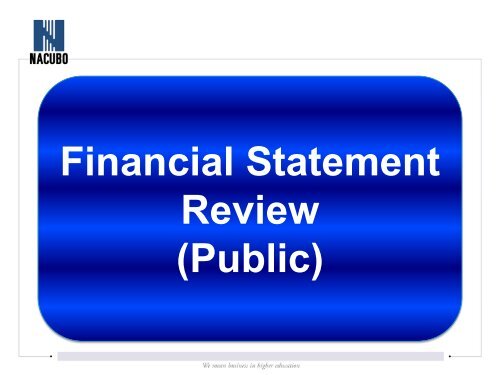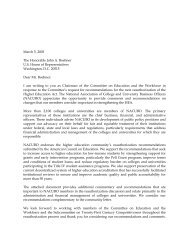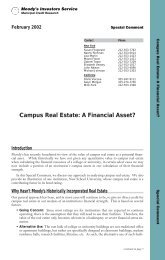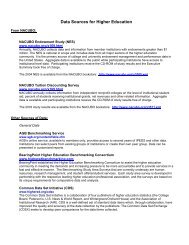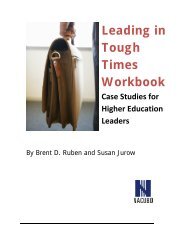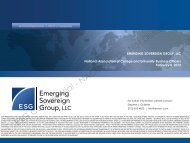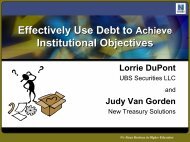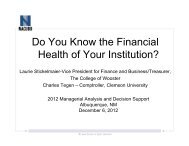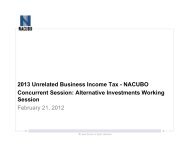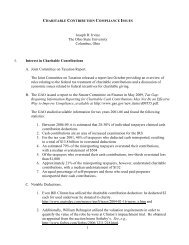Financial Statement Review (Public) - NACUBO
Financial Statement Review (Public) - NACUBO
Financial Statement Review (Public) - NACUBO
- No tags were found...
You also want an ePaper? Increase the reach of your titles
YUMPU automatically turns print PDFs into web optimized ePapers that Google loves.
MANAGEMENT DISCUSSION AND ANALYSIS• Consider starting with discussion of statement of revenuesand expenses – it generally drives changes in the statementof net assets!• Provide the ‘why’ when commenting on significant changesfrom prior year(University of Idaho example)• Stay away from covering topics/information not specificallyrequired by GASB 34• Adopt the ‘Dragnet’ approach – “just give me thefacts…ma’am”6
MANAGEMENT DISCUSSION AND ANALYSIS• Discussion of currently known facts,circumstances, decisions and their financialimpacts could be significantly improvedo (University of California example)7
<strong>Statement</strong> 60Accounting and Reporting for ServiceConcession Arrangements8
SERVICE CONCESSION ARRANGEMENTSWhat is an SCA?An arrangement in which:• a transferor conveys to an operator the right and relatedobligation to provide services to the public through theoperation of a capital asset, in exchange for significantconsideration• the operator collects and retains fees from third parties9
SERVICE CONCESSION ARRANGEMENTSWhat is an SCA?An arrangement in which (continued):• the transferor determines, modifies, or approves:o What services the operator is required to provideo To whom the services will be providedo The prices or rates that will be charged• the transferor is entitled to significant residual interest inthe capital asset(GASB 60 flowchart resource)10
SERVICE CONCESSION ARRANGEMENTSTRANSFEROR ACCOUNTING• After initial measurement, the capital asset is subjectto existing reporting requirements• Improvements made to the facility would increasethe transferor’s asset• Does NOT depreciate if arrangement requiresoperator to return facility to transferor in its originalor enhanced condition11
SERVICE CONCESSION ARRANGEMENTSTRANSFEROR ACCOUNTING• A liability is recorded at present value if acontractual obligation exists AND if it meetseither of the following criteria:o 1) Directly relates to the facility, ORo 2) Relates to a commitment by the transferor tomaintain a minimum or specific level of service inconnection with the operation of facility.12
SERVICE CONCESSION ARRANGEMENTS• Revenue is recognized in a systematic and rationalmanner over the term of arrangement as thedeferred inflow is reduced• Liability is reduced as transferor’s obligations aresatisfiedo When obligation is satisfied, a deferred inflow isreported and related revenue is recognized insystematic and rational manner over the term13
SERVICE CONCESSION ARRANGEMENTSWhat about the Governmental operator?14
SERVICE CONCESSION ARRANGEMENTSGovernmental operator• Reports an intangible asset for the right to accessand use the property• Improvements made to the facility by thegovernment operator increases the operator’sintangible asset if improvements increase theefficiency capacity of the facility15
SERVICE CONCESSION ARRANGEMENTSOther provisions• Revenue-sharing arrangementso Governmental operator reports all revenues earned andexpenses incurredo Unconditional payments treated like installmentso The transferor recognizes conditional amounts whenearned• Disclosureso Description of the arrangement includingmanagement’s objectives for entering the arrangemento Nature and extent of rights retained or transferredo Nature and amounts recognized in the statements16
<strong>Statement</strong> 61The <strong>Financial</strong> Reporting Entity—Omnibus17
REPORTING ENTITYThe most significant effects of the amendmentsare to:o Increase the emphasis on financialrelationshipso Clarify the requirements to blend certaincomponent unitso Improve recognition of ownership interests• Joint ventures• Component units18
REPORTING ENTITY• <strong>Statement</strong> 14 requires inclusion in the reportingentity if a Potential Component Unit is fiscallydependent. That is,• Budget, or• Setting taxes or charges, or• Issuing debt• <strong>Statement</strong> 61 adds the additional requirement for afinancial benefit or burden to exist before inclusionin the reporting entity is required(GASB 61 flowchart)19
REPORTING ENTITY• Current year issues to considero Reporting options for FASB reporting componentunits (CIG 4.33.1-4)(University of Alaska Foundation)o Concerns that implementation of the GASB 61 willresult in ‘de-blending’ entities formerly blended• Relationships that lack financial benefit/burdeno Need to review changes to bylaws and othergoverning documents that establish relationships20
POSSIBILITY OF DE-BLENDINGImpact for “de-blending” situations:• Formatting of the financial statements• <strong>Statement</strong> of cash flows• Note disclosures for major component units• Segregation of disclosures for DCU’s• Recognition of equity interests• Changes in opinion units• Group audit considerations21
<strong>Statement</strong> 62Codification of Pre-November 30, 1989FASB and AICPA Pronouncements22
GASB 62 - CODIFICATION OF PRE-NOVEMBER 30,1989 FASB AND AICPA PRONOUNCEMENTS• Special and extraordinary items (APB Opinion 30)• Comparative financial statements (ARB 43)• Related parties (FASB <strong>Statement</strong> 57)• Prior-period adjustments (FASB <strong>Statement</strong> 16 and APB Opinion 9)• Accounting changes and error corrections (APB Opinion 20 andFASB Interpretation 20)• Contingencies (FASB <strong>Statement</strong> 5 and FASB Interpretation 14)• Extinguishments of debt (APB Opinion 26 and FASB <strong>Statement</strong> 76)• Inventory (ARB 43)• Leases (FASB <strong>Statement</strong>s 13, 22, and 98 and FASB Interpretations23, 26, and 27)23
GASB 62 - BASIC GUIDANCE• Supersedes <strong>Statement</strong> 20!o All applicable pre-11/30/89 standards are in GASB’scodificationo All applicable post-11/30/89 non-GASB standardsare considered “other accounting literature”(Old GASB 20 footnote no longer needed)o Accounting changes to apply <strong>Statement</strong> 62 should beretroactively applied24
BASIC FINANCIAL STATEMENTSGASB VS. FASB• Too often, state legal guidance is used• Guidance is currently only found in AICPA auditand accounting guides• GASB – Level B GAAP• FASB – other accounting literature(Link to State and Local Government Audit Guide)25
BASIC FINANCIAL STATEMENTS - GAAP• Reporting employee benefit trust fundso If the University has fiduciary responsibilities forsingle employer pension and OPEB plans accountedfor in separate legal trust accounts – the Universityshould be including the trust fund financialstatements within the University’s financialstatements• Confusion interpreting guidance in GASB 34(University of California example)26
<strong>Statement</strong> 63<strong>Financial</strong> Reporting of Deferred Outflows ofResources, Deferred Inflows of Resources and NetPosition27
GASB 63 - BACKGROUND INFORMATIONConcepts <strong>Statement</strong> 4 identifies 5 elements that make up astatement of financial position:• Assets• Liabilities• Deferred outflows of resources• Deferred inflows of resources• Net positionThis differs from the composition currently required by<strong>Statement</strong> 34, which requires the presentation of• Assets• Liabilities• Net assets28
GASB 63 - DISPLAY REQUIREMENTS• Deferred outflows of resources should be reported in aseparate section following assets• Deferred inflows of resources should be reported in aseparate section following liabilities• Net position components resemble the existingcomponents of net assets, but also include the effects ofdeferred outflows of resources and deferred inflows ofresources• Net investment in capital assets• Restricted• Unrestricted(University of California example)29
GASB 63 – CURRENT DEFERRALS• There are few items that GASB standards requireto be reported as deferred outflows/inflows ofresources as of today:o <strong>Statement</strong> 53–Derivative Instrumentso <strong>Statement</strong> 60–Service Concession Arrangements• NOT SO FAST…<strong>Statement</strong>s 65, 67, 68 and 69 alsohave items that are reported as deferredoutflows of resources or deferred inflows ofresources.30
FOOTNOTES• Summary of significant accounting policeso Component unit disclosures• Sufficient disclosures for the reader to understand– How an entity meets criteria to be reported as acomponent unit– Why a component unit is blended or discretely presented(Clemson University example)32
FOOTNOTES• Cash/Investmentso Investment disclosures should be organized byinvestment type, such as U.S. Treasuries, corporatebonds, or commercial paper. Dissimilar investments,such as U.S. Treasury bills and U.S. Treasury strips,should not be aggregated into a single investmenttype.o Disclosures should be made for fiduciary funds andcomponent units when significant(CUS Investment Classifications)33
FOOTNOTES• Receivableso Details about receivables aggregated in the financialstatements when those aggregations obscuresignificant components of the receivables• (GASB <strong>Statement</strong> No. 38, Certain <strong>Financial</strong> <strong>Statement</strong> NoteDisclosures, paragraph 13)34
FOOTNOTES• Capital assetso Roll-forward table of classes of capital assets andbalances(Capital asset roll-forward table example)35
FOOTNOTES• Long-term debt – generalo variable rate debt - often missing disclosure of theterms by which the interest rate varies• Watch your current and non-current classification forvariable rate demand bondso Interest rate swaps• Disclosure of significant terms and fair valueo Best practice, and GFOA Certificate requirements• Original amount of the debt issued (WSU example)• Applicability of Federal arbitrage regulations36
FOOTNOES• Pension plans – commonly missed disclosureso Type of plan – single, agent multi-employer, costsharing defined benefit plan, defined contributionplano Authority for making changes to both planprovisions, as well as contribution requirements37
FOOTNOTES• Pension plans – commonly missed disclosureso Value of plan net assetso Current years schedule of funding progresso Annual Pension Contribution (APC) and employercontribution informationo Disclosures should focus on APC as adjusted forcumulative over/under funding38
REQUIRED SUPPLEMENTARY INFORMATION• Omitting pension and OPEB trend informationfor sole and agent employer planso Appears to duplicate information required in thenotes – but still required39
QUESTIONS???40
The material appearing in this presentation is for informational purposesonly and is not legal or accounting advice. Communication of thisinformation is not intended to create, and receipt does not constitute, alegal relationship, including, but not limited to, an accountant-clientrelationship. Although these materials may have been prepared byprofessionals, they should not be used as a substitute for professionalservices. If legal, accounting, or other professional advice is required, theservices of a professional should be sought.41
Bio’sJim Lanzarotta, Partner, is the national practice leader for theFirm’s State and Local Government Services Group. He is theAICPA’s representative to the Government Accounting StandardsAdvisory Council responsible for assisting the GASB with itsproject agenda, and providing feedback on proposed accountingstandards and reporting issues. He just completed six years ofservice, the last three as chair, of the AICPA State and LocalGovernment Expert Panel responsible for reviewing all proposedaccounting and auditing standards and providing feedback onbehalf of the AICPA, as well as updates to AICPA publicationsincluding the Audit Guide to State and Local Governments, AuditRisk Alerts, and Practice Aids.Moss Adams, LLPJames.Lanzarotta@mossadams.com541-225-607042
Thank You43


